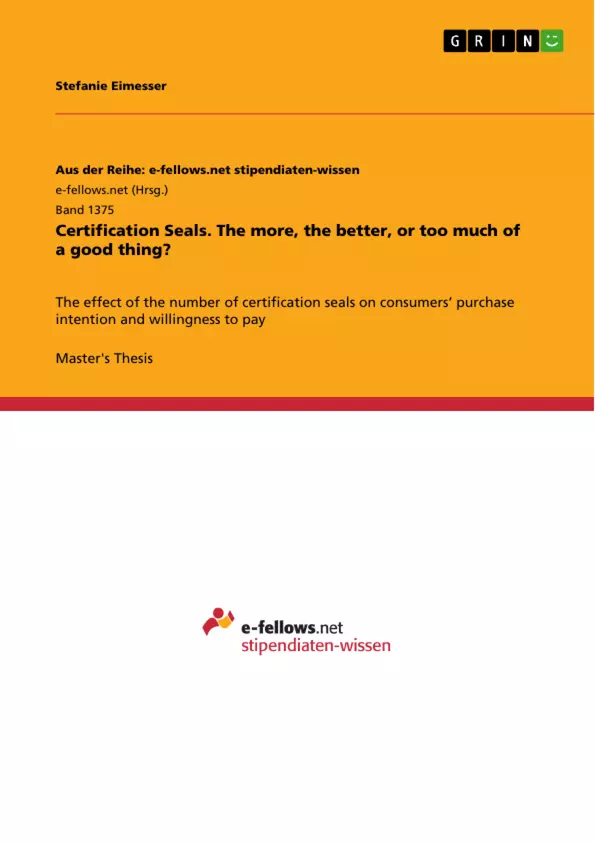This thesis investigated whether and how consumers’ purchase intention and willingness to pay for food products are affected by the number of certification seals and the level of pretension of a product benefit claim presented on the product packaging. Its objective was to find the ideal number of seals and level of claim pretentiousness where purchase intention and willingness to pay are highest and to give an explanation about consumers’ thought processes that may lead to this outcome. To this end, the role of consumers’ perception of the product quality and the manufacturer conscientiousness has been taken into consideration.
With reference to existing literature on product certification as well as concepts originating from human information processing theory and advertising research this study suspected that consumer attitudes and purchase intentions first increase up to a maximum point before decreasing again as the number of certification seals being employed simultaneously rises. The author furthermore hypothesized that consumers react negatively to a more pretentious benefit claim in terms of less favourable product and manufacturer attitudes and lower purchase intentions. The interaction effect of the number of seals and the pretentiousness of a benefit claim on manufacturer conscientiousness perception, product quality perception, purchase intention and willingness to pay was assumed to be likewise of inverted-U nature after the presence of a certification seal has offset the negative effect of a pretentious claim.
These hypotheses about the direct impact of the two types of extrinsic product attributes as well as additional hypotheses about the mediating role of product quality perception and manufacturer conscientiousness perception in the relationships between the extrinsic product attributes and consumers’ purchase intentions have been tested by means of a survey-based framed field experiment in a real-world retail environment. A factorial 5 (# of seals: 0,1,2,3,4) x 2 (claim: modest, pretentious) between-subject research design exposed grocery shoppers randomly to one of 10 different experiment conditions consisting of jars of jam of a fictive brand with a different number and combination of the 4 seals ‘BIO', ‘Bioland’, ‘Demeter’ and ‘Naturland’, and the two organic claims “Simply organic” and “More organic does not exist!”. The collected primary data has been analysed by means of multivariate Analysis of Variance and Regression Analysis.
Table of Contents
- Preface
- Executive Summary
- 1. Introduction
- 1.1 The dilemma of brand managers
- 1.2 Research objective
- 1.3 Research relevance
- 1.3.1 Academic relevance
- 1.3.2 Managerial relevance
- 1.4 Research outline
- 2. Theoretical background
- 2.1 The role of certification seals as signals
- 2.2 The impact of multiple certification seals
- 2.2.1 The effect on purchase intention and willingness to pay
- 2.2.2 The mediating role of product quality perception
- 2.2.3 The mediating role of manufacturer conscientiousness perception
- 2.3 The impact of a product benefit claim
- 2.3.1 The effect on purchase intention and willingness to pay
- 2.3.2 The mediating role of product quality perception
- 2.3.3 The mediating role of manufacturer conscientiousness perception
- 2.4 The combined impact of multiple certification seals and a product benefit claim
- 2.4.1 The effect on purchase intention and willingness to pay
- 2.4.2 The mediating role of product quality perception
- 2.4.3 The mediating role of manufacturer conscientiousness perception
- 3. Methodology
- 3.1 Research method and general research design
- 3.2 Pre-test
- 3.2.1 Determination of research stimuli
- 3.2.2 Data collection pre-test
- 3.2.3 Pre-test results
Objectives and Key Themes
This master thesis explores the influence of the number of certification seals on consumer purchase intention and willingness to pay for food products. The study seeks to identify the optimal number of seals and level of claim pretentiousness that maximize purchase intention and willingness to pay. It also aims to understand the underlying thought processes that lead to these outcomes. The study investigates the role of consumers' perception of product quality and manufacturer conscientiousness in the decision-making process.
- The impact of multiple certification seals on consumer behaviour
- The role of product quality perception in influencing purchase intention
- The significance of manufacturer conscientiousness perception in consumer decision making
- The influence of benefit claim pretentiousness on purchase intentions
- The combined effect of certification seals and benefit claim pretentiousness on purchase intentions
Chapter Summaries
The introduction outlines the dilemma faced by brand managers regarding the effectiveness of certification seals. The research objective is to investigate the impact of multiple certification seals on consumer purchase intention and willingness to pay. The academic and managerial relevance of the study are discussed, and the research outline is presented.
Chapter 2 delves into the theoretical background, exploring the role of certification seals as signals and their impact on purchase intention and willingness to pay. The chapter examines the mediating roles of product quality perception and manufacturer conscientiousness perception in the relationship between certification seals and consumer behaviour. It further analyzes the impact of product benefit claims, including their effect on purchase intention, willingness to pay, and the mediating roles of product quality perception and manufacturer conscientiousness perception.
Chapter 3 discusses the methodology employed in the research, including the research method, general research design, and the pre-test conducted to determine research stimuli and collect data.
Keywords
The core keywords and concepts explored in this study include certification seals, benefit claim, signalling, consumer decision process, purchase intention, willingness to pay, product quality perception, and manufacturer conscientiousness perception. The study focuses on understanding how these factors influence consumer behaviour in the context of food product purchasing.
- Citar trabajo
- Stefanie Eimesser (Autor), 2013, Certification Seals. The more, the better, or too much of a good thing?, Múnich, GRIN Verlag, https://www.grin.com/document/300161



